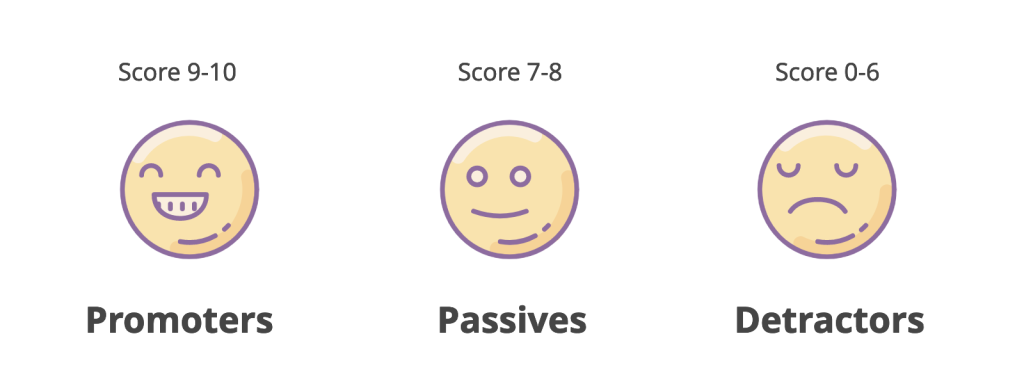What is an NPS Detractor: How to Turn Detractors into Promoters
Are you unhappy with the number of detractors on your NPS score? Wondering if you could turn those detractors into promoters and how to do it?
I admit – The results of your very first NPS survey can be disappointing. This is particularly true if you haven’t set any NPS goals and do not know the benchmarks in your industry.
(TIP: The SaaS average is actually around 30).
Because of that, you might expect a different result. And so the actual result might seem a little… upsetting.
What might be particularly worrying is the number of NPS detractors.
Well, here’s the thing – Having detractors is quite common. It’s not ideal, of course, but overall, you aren’t the only SaaS brand seeing detractors on their NPS score. More importantly, you can convert them into promoters.
In this guide, I’ll show you exactly how to do it.
But before getting into the practical tips, let’s get some theory out of the way, shall we?
What Is an NPS Detractor?
In simple terms, NPS detractors are unhappy customers — they are unsatisfied with the product, service, or experience you offer.
In business, however, the term “detractor” is often associated with a segment of NPS survey respondents. Here, detractors are people who score your SaaS from 0 to 6.
Essentially, though, it’s the same thing: only unhappy customers respond with a score between 0 and 6.
How to Identify Your NPS Detractors?
This is a bummer for us, founders, isn’t it? Only 1 out of 26 unhappy customers ever complain.
(And, as a matter of fact, viewing this absence of feedback as a sign of satisfaction makes the initial NPS results look disappointing.)
What this means is that you can’t rely on customers to tell you that they are “detractors”; you’ll have to identify them proactively.
Here are a few ways to spot detractors:
1. Run an NPS survey
This may seem obvious but the simplest way to uncover how many NPS detractors you have is by running an NPS survey.
A dedicated NPS survey software will quickly calculate your scores and display them in a dashboard. But what’s more, you’ll also get access to the information about who your detractors are so you can try to turn them into promoters.
NPS (registered trademark of Bain & Company) surveys measure customer satisfaction and customer loyalty to a company by asking a 10-point question like this:

Here, those who give a score from 0 to 6 identify as detractors. Similarly, passives give 7 or 8, and promoters give 9 or 10.
2. Run other customer surveys
Besides NPS, you can also run CSAT or CES customer surveys to pinpoint detractors.
Now, neither CSAT nor CES labels a particular segment of customers “detractors” like NPS does. However, both are customer satisfaction metrics, and you can bet that dissatisfied customers (according to both surveys) are detractors.
- CSAT (customer satisfaction) survey is a feedback survey that measures customers’ satisfaction level with your product, service, or experience. Typically, customers are asked a Likert scale question like this at crucial points of interaction (example: after billing, onboarding, customer support, etc.)
And if someone’s response to this is below neutral, you can identify them as a detractor.
- CES (Customer Effort Score) measures the ease of using your SaaS by asking a direct question such as:
If someone finds interacting with your product or service difficult, you can be pretty sure they are frustrated and likely detractors. For example, if your checkout process is complicated, 74% of customers are likely to switch brands.
3. Use churn-prediction software
Churn prediction software or customer health monitoring software helps find customers on the verge of churning.
These software use factors like the following into consideration:
- Product usage
- Use of particular features
- Total renewals
- Number of upsells and cross-sells the customer bought
- Customer feedback, etc.
And gives you answer to questions like:
- Will the customer churn or not?
- Will they repurchase your SaaS subscription?
- Will they downgrade the subscription plan?
The overview result you’ll get will be in the form of a score per customer:
- 0-35: Requires attention
- 35-70: Take notice
- 70-100: Doing well/Healthy
Consider customers with scores under 35 as detractors.
Note: You can also find detractors by manually looking at each factor customer heath scoring systems account in calculating.

Why You MUST Turn Detractors Into Promoters
There is a couple of reasons, actually:
#1. Detractors can harm your brand image
Detractors can not only leave you and stop using your product. They can also discourage others from trying out your app by spreading negative word-of-mouth.
Don’t believe me? Well, consider these statistics:
- It takes 40 positive customer experiences to negate the poor impression created by one negative review.
- News of bad customer service reaches twice as many ears as news of good customer service.
- Americans tell an average of 9 people about good experiences and tell 16 (nearly two times more) people about poor experiences.
On the contrary, if you convert detractors into promoters, your SaaS will get positive reviews, and that uplift in the brand image will lead to more sales. Here’s a relevant, interesting stat:
- Positive word-of-mouth marketing impressions result in 5x more sales than a paid media impression.

2. Having too many detractors can bring your profits down
Detractors = churn, typically.
And needless to say, every customer that leaves you reduces your predictable revenue.
What’s more, they are unlikely to come back ever again. 91% of unhappy customers will not willingly do business with a brand again, after all.
Also, as I mentioned above, detractors will keep others from purchasing from you — and will cut your future potential income.
But the worst of all, detractors can leave before you can recover the money you spent on acquiring them.
The median SaaS startup spends about 92% of the first-year average contract value on the sale, implying an 11 month payback period on the CAC (customer acquisition cost). In other words, if the customer becomes a detractor and leaves before 11 months, you’ll be at a loss.
Tip: Try to get customers to subscribe to an annual plan so even if they become detractors in between the subscription period, they’ll more probably not leave until the subscription is over. In the meantime, you can put efforts into converting them into promoters.
#3. Your detractors will fill your competitors coffers with dime
A typical detractor wants the solution your company provides, but they don’t want anything to do with you. So, naturally, they look for alternatives and switch to a competitor. And if they like it there, they boost their profits as well as image.
Imagine someone tweeting, “I switched from [Your Company] to [Competitor SaaS] last month, and I don’t think I am leaving [Competitor SaaS] ever again!”
Not only does it destroy your brand image, but it also uplifts the competitor’s image. Plus, of course, it’s more money in the competitor’s pocket (that used to be in yours).
7 Ways To Turn NPS Detractors Into Promoters
Identifying detractors is step-0 of converting detractors into promoters.
Here’s what to do next:
1. Encourage Providing Feedback
Feedback is your friend. The more you have it, the better you can assess customer needs, take action, and convert detractors to promoters.
As I mentioned, only 1 out of 26 unhappy customers complain—the rest churn. So if you want to hear from significantly more unhappy customers, you need to make it easier for them to voice their opinions.
Here are a few things you can do:
- Add a follow-up question to your customer surveys (NPS, CSAT, CES).
- Send customer surveys at an appropriate time to get maximum responses. For example, send a CSAT survey soon after they chat with a customer service representative.
(Related reads: Best Time to Send NPS Survey and When and How Often to Send a CSAT Survey)
- Similarly, share those surveys at the best place – popup through an in-app widget, email, live chat, etc.
- Include a link to “share feedback” in all your emails and other promotional materials. In fact, encourage them to reply to your emails (even promotional ones).
- Trigger a proactive live chat message and ask them if they need any help.
- Keep contact details and feedback form at the most easy-to-locate place on your website. For example, you can embed a floating feedback button at the side of your web pages.
- Practice social listening and take customer queries from social media.
2. Respond quickly
I mean “respond quickly (to detractors)” in two contexts:
1. Respond to the feedback quickly.
When someone shares their feedback, respond as fast as you can, both in terms of acknowledgment and action.
- Firstly, respond to the actual feedback.
An automated message like “Thanks for sharing your feedback…” works. However, a personalized message that focuses on the customer’s frustration and shares the plan to solve it works best. For example, here’s Mailmeteor’s response to being asked about not having the follow-up feature on their app:

Such approach acknowledges the customer’s pain point. It also ensures the customer that the problem will disappear soon.
- Secondly, take quick action on the feedback and solve customer frustration.
2. Respond quickly, in general.
“Slow response times are by far the biggest frustration for buyers” – Mckinsey Research.
Even regular customers don’t like getting late replies. So imagine the detractors’ frustration if they don’t get immediate replies to their queries.
Therefore, prioritize responding to all detractors’ queries and keep them happy on that front at least.
3. Be empathetic
Unless your customer is an age-old enemy, they don’t want to be frustrated with your product or service. Detractors are customers first, detractors second. So be empathetic and understand their point of view.
Listen to their complaints, apologize, acknowledge their needs, and take action. Do not get defensive. (Here are a few examples of non-defensive responses.)
Tip: Consider gifting a coupon, an extended free trial, an additional month on their subscription, etc., as a token of apology.
4. Integrate NPS scores into your CRM
How will your customer service department know that the message or call is from a detractor and hence must be taken care of with utmost care? By enabling them to see the NPS results and previous conversations.
For example, you can integrate Refiner with your favorite CRM and enrich customer profiles with survey results. So when someone contacts the CS department, the executive can see their previous complaints and overall attitude toward the company.
5. Make a result-driven plan
You collect feedback to understand customer frustration. And you understand customer frustration to eliminate it.
To eliminate, you need an action plan. Here’s how you make one:
Step 1: Prioritize your goals. Each customer will have a different problem with your product or service. Obviously, you can’t solve all issues at once, so prioritize by problem frequency. For example, if 10 people ask to add X feature and 5 ask about the Y feature, prioritize X. (Of course, I am missing nuance here, but you get the point).
Step 2: Consult the relevant team. Share survey results with the CS team if complaints are about support, with the development team if it’s about the product, etc., and ask for their input.
Step 3: Make the plan. Consider experts’ input and make a plan. The plan should include details on what’s to be achieved, how, and by when.
Tip: Once you have a solid plan, consider updating relevant detractors about it. They’ll feel heard and know you are taking quick action to solve their issues.
6. Deliver on the promise
It goes without saying, deliver on what you promised your customers. On a similar note, do not promise if you can’t keep it. In fact, go with the classic “Underpromise, Overdeliver.”
For example, say a customer mentions X integration with your SaaS would be nice. If you can develop the integration in 2 months, tell them they’ll have it by next quarter.
Note: Do not underpromise much. Customers will rather switch to a company with the feature they need than stay with you for 6 months in the hope of the feature.
7. Close the feedback loop
You kind of close the loop when you promise action on the customer’s feedback. However, the actual feedback loop will close when you perform the action and update the customer about it.
Therefore, once you deliver on the promise:
- Thank the customer for their feedback
- Tell them you took action
- Ask for more feedback — that’s how you make the customer journey ideal.
Conclusion
Converting NPS detractors into promoters isn’t easy. However, it’s not impossible either. If you perform the fundamental tips I mentioned in this article, you’ll achieve the goal.
Not only will you convert current detractors into promoters, but you’ll also stop future customers from becoming detractors by making customer-centric decisions.
Of course, realistically, you can’t convert every detractor, but the best you can do is try. So, try! Good luck!










